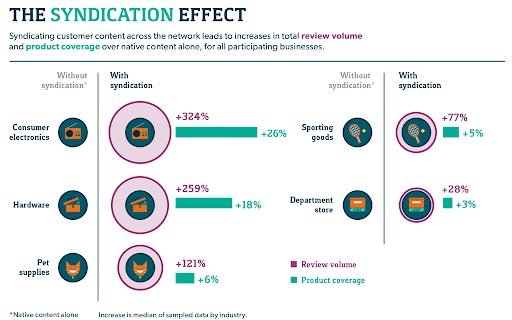For the longest time, web content had one purpose - to get pushed on a web page. But everyone today wants content to be available across the board - on mobile devices, native apps, digital signage, and show up on third-party sites and social networks - if it is to garner the right audience.
However, making this happen is easier said than done. Some of the persistent challenges faced by large editorial teams involve:
-
Coordinating and approving content that’s ready to go live
-
Ensuring authors and contributors can access a central system to create/submit content
-
Publishing a number of content pieces on different websites/subdomains.
Introducing Content Staging, Synchronization, and Syndication
Between 2010 and 2016, the media consumption grew at a 2% rate. It makes one thing clear that people love to consume content and they will in the future as well.
This, in turn, puts a lot of pressure on content creators and marketers to create and push new pieces of content.
Here’s how you can ensure quality and quantity production:
Staging
Creating quality content involves a lot of work, checks, and approval. Big publishing websites might come across several challenges in the process, such as:
-
Publishing a number of articles at the same time, and doing it across different websites/ sub-domains
-
Getting approval in a centralized system
Intricate publishing workflow is a critical part of the content strategy for any organization that employs distributed management. Editing the content on the live site can result in accidental publishing. To avoid that, a separate staging environment is needed in a robust workflow.
Staging and publishing without requiring the editor to log into the target site is what content staging would help with.
Synchronization
Once the content is approved on the different environments, it must be automatically updated for other website environments. Synchronization helps you keep your environments in perfect sync by automating the secure provisioning of content, code, templates and digital assets between them.
Source: content Sync
Administrators can create and schedule multiple synchronization tasks to automatically occur in the future. It will target different destination servers and websites, or manually execute synchronization tasks through the user interface.
Developers can leverage the API and event handlers to automatically synchronize any type of staging tasks according to custom requirements.
Syndication
The web is big and noisy. So much so that even though you are targeting a niche audience, chances of them landing on your blog depletes with each day. Syndication gets your content in front of a different audience who might not be aware of your website otherwise.
“Syndication is important because it generates brand awareness and more traffic.”
 Drupal websites often syndicate content from Drupal planet
Drupal websites often syndicate content from Drupal planet
In simple terms, content syndication is republishing the content on a third-party website. Syndication works great for national and international media and publishing websites. There is no restriction on the kind of content that can be syndicated. The list can include blog posts, articles, infographics, videos and more.
It is a low-cost strategy which media and publishing websites like Huffington Post, CNN, and NYTimes often use to garner a new audience. Syndication brings free exposure, backlinks, and greater organic traffic.

However, syndicated content is ultimately duplicate content. And duplicate content can create havoc with your SEO because Google loves unique content.
While ranking the content it will only index the version that is original and larger, high-traffic website. You can make your syndicated content SEO-friendly by ensuring it is indexed correctly, on your site and on your syndication partner’s site.
Drupal Solutions for Content Staging, Synchronization, and Syndication
Drupal’s digital experience platform knows that your content must reach more than just websites. So yes, of course, it has modules for staging, syncing and syndication.
1. Workflow
Workflow, as the name suggests creates arbitrary workflows. Creating different workflows for the content saved as ‘draft’, ‘review’ and ‘published’, it can be assigned to the story node type.
-
Only users with role 'chief editor' can set stories to the published state. It also allows to set up workflow to alter states from form, page, comment, a special block, and a special workflow tab.
-
For content editors, it allows managing the view/edit/delete permissions for content types per user role and workflow state with its sub-module Workflow Access.
-
Another action it allows is the transition from Review to Published so that the node's status is set to Published (and becomes visible on the website).
This module is available for Drupal 8.
2. Deploy
The Deploy module lets users to easily stage and preview content. It can manage the dependencies between different entities, like node references, automatically.
Designed to have a rich API which can be easily extended in a variety of content staging situations, Deploy can be used for both single and cross-site staging.
It should be noted that the Deploy module doesn't provide any settings or configuration pages, and the user must ensure that the target workspaces and/or remotes are configured correctly (workspaces configuration pages are provided by Workspace module).
For UI, Deploy provides just a link to run a deployment between current active workspace and its target.
This module is available for Drupal 8.
3. CMS Content Sync
CMS Content Sync provides content synchronization features between Drupal sites using a Node.js based Sync Core. It is built to support the synchronization of a huge amount of data, including content and media assets between many Drupal sites that can't be handled by Drupal itself.
Source: DrupalEurope
The three use cases for the CMS content sync are:
Content Staging: Content Sync allows you to test code updates with your content and publish code and content simultaneously. It further allows editorial review processes to ensure consistent quality of content.
Content Syndication: For distributed teams, it allows the content to be updated and deleted centrally. It pushes content and media items at any of your sites to publish them on any targeted remote site automatically.
Content Pool: This feature lets you update and delete these items from the source site or allows you to completely customize it on the remote site. Further, you can connect the remote sites. Each content item comes with a preview and link to the source site that makes it easy to identify and select.
If your enterprise manages a large volume of content over a multi-site architecture, staging, syndication, and sync are crucial. Srijan’s expert teams can help you optimize these processes and follow industry best practices. Just drop us a line and our team will be in touch.
Our Services
Customer Experience Management
- Content Management
- Marketing Automation
- Mobile Application Development
- Drupal Support and Maintanence
Enterprise Modernization, Platforms & Cloud
- Modernization Strategy
- API Management & Developer Portals
- Hybrid Cloud & Cloud Native Platforms
- Site Reliability Engineering




